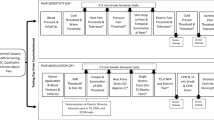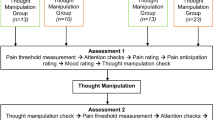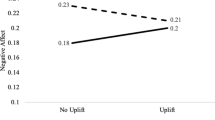Abstract
Exposure to stress is associated with poor outcomes in people with chronic pain. Dispositional variables, such as pain catastrophizing and distress intolerance, may impact reactivity to stressors. Importantly, these variables can be modified with treatment. The aim of this study was to investigate whether pain catastrophizing and distress intolerance were associated with tolerance of a pain stressor or a psychosocial stressor, and heightened negative affect following these stressors. A sample of 50 adults with chronic pain completed self-report measures and pain and psychosocial stress inductions. Results indicated that pain catastrophizing was associated with heightened anxiety during pain induction. Distress intolerance was associated with negative affect following a psychosocial stressor, and with poorer tolerance of the psychosocial stressor. Pain catastrophizing and distress intolerance are related factors, however, they exhibit distinct associations with amplification of pain and psychosocial stress reactivity. These variables may be important treatment targets in people with chronic pain.
Similar content being viewed by others
References
Bornovalova, M. A., Gratz, K. L., Daughters, S. B., Hunt, E. D., & Lejuez, C. W. (2012). Initial RCT of a distress tolerance treatment for individuals with substance use disorders. Drug and Alcohol Dependence,122, 70–76. https://doi.org/10.1016/j.drugalcdep.2011.09.012
Cruz-Almeida, Y., & Fillingim, R. B. (2014). Can quantitative sensory testing move us closer to mechanism-based pain management? Pain Medicine,15, 61–72. https://doi.org/10.1111/pme.12230
Dugas, M. J., Buhr, K., & Ladouceur, R. (2004). The role of intolerance of uncertainty in etiology and maintenance. In R. G. Heimberg, C. L. Turk, & D. S. Mennin (Eds.), Generalized anxiety disorder: Advances in research and practice (pp. 143–163). New York, NY, US: Guilford Press.
Edwards, R. R., Dolman, A. J., Michna, E., Katz, J. N., Nedeljkovic, S. S., Janfaza, D., et al. (2016a). Changes in pain sensitivity and pain modulation during oral opioid treatment: The impact of negative affect. Pain Medicine,17, 1882–1891.
Edwards, R. R., Dworkin, R. H., Sullivan, M. D., Turk, D. C., & Wasan, A. D. (2016b). The role of psychosocial processes in the development and maintenance of chronic pain. Journal of Pain,17, 70–92. https://doi.org/10.1016/j.jpain.2016.01.001
Grossman, P., Tiefenthaler-Gilmer, U., Raysz, A., & Kesper, U. (2007). Mindfulness training as an intervention for fibromyalgia: evidence of postintervention and 3-year follow-up benefits in well-being. Psychotherapy and Psychosomatics,76, 226–233.
Harrington, N. (2005a). It’s too difficult! Frustration intolerance beliefs and procrastination. Personality and Individual Differences,39, 873–883.
Harrington, N. (2005b). The Frustration Discomfort Scale: Development and psychometric properties. Clinical Psychology and Psychotherapy.,12, 374–387.
Hübscher, M., Moloney, N., Leaver, A., Rebbeck, T., McAuley, J. H., & Refshauge, K. M. (2013). Relationship between quantitative sensory testing and pain or disability in people with spinal pain-a systematic review and meta-analysis. Pain,154, 1497–1504. https://doi.org/10.1016/j.pain.2013.05.031
Kahler, C. W., McHugh, R. K., Metrik, J., Spillane, N. S., & Rohsenow, D. J. (2012). Breath holding duration and self-reported smoking abstinence intolerance as predictors of smoking lapse behavior in a laboratory analog task. Nicotine & Tobacco Research,15, 1151–1154. https://doi.org/10.1093/ntr/nts231
Kjøgx, H., Kasch, H., Zachariae, R., Svensson, P., Jensen, T. S., & Vase, L. (2016). Experimental manipulations of pain catastrophizing influence pain levels in patients with chronic pain and healthy volunteers. Pain,157, 1287–1296. https://doi.org/10.1097/j.pain.0000000000000519
Leyro, T. M., Zvolensky, M. J., & Bernstein, A. (2010). Distress tolerance and psychopathological symptoms and disorders: A review of the empirical literature among adults. Psychological Bulletin,136, 576–600. https://doi.org/10.1037/a0019712
Linton, S. J. (2000). A review of psychological risk factors in back and neck pain. Spine,25, 1148–1156.
Marcuzzi, A., Dean, C. M., Wrigley, P. J., & Hush, J. M. (2015). Early changes in somatosensory function in spinal pain: A systematic review and meta-analysis. Pain,156, 203–214. https://doi.org/10.1097/01.j.pain.0000460300.10583.f6
Martel, M. O., Dolman, A. J., Edwards, R. R., Jamison, R. N., & Wasan, A. D. (2014). The association between negative affect and prescription opioid misuse in patients with chronic pain: The mediating role of opioid craving. The Journal of Pain,15, 90–100. https://doi.org/10.1016/j.jpain.2013.09.014
Martel, M. O., Wasan, A. D., Jamison, R. N., & Edwards, R. R. (2013). Catastrophic thinking and increased risk for prescription opioid misuse in patients with chronic pain. Drug and Alcohol Dependence,132, 335–341. https://doi.org/10.1016/j.drugalcdep.2013.02.034
McHugh, R. K., Kertz, S. J., Weiss, R. B., Baskin-Sommers, A. R., Hearon, B. A., & Björgvinsson, T. (2014). Changes in distress intolerance and treatment outcome in a partial hospital setting. Behavior Therapy,45, 232–240. https://doi.org/10.1016/j.beth.2013.11.002
McHugh, R. K., & Otto, M. W. (2011). Domain-general and domain-specific strategies for the assessment of distress intolerance. Psychology of Addictive Behaviors,25, 745–749. https://doi.org/10.1037/a0025094
McHugh, R. K., & Otto, M. W. (2012a). Refining the measurement of distress intolerance. Behavior Therapy,43, 641–651. https://doi.org/10.1016/j.beth.2011.12.001
McHugh, R. K., & Otto, M. W. (2012b). Profiles of distress intolerance in a substance-dependent sample. The American Journal of Drug and Alcohol Abuse,38, 161–165. https://doi.org/10.3109/00952990.2011.643990
McHugh, R. K., Weiss, R. D., Cornelius, M., Martel, M. O., Jamison, R. N., & Edwards, R. R. (2016). Distress intolerance and prescription opioid misuse among patients with chronic pain. The Journal of Pain,17, 806–814. https://doi.org/10.1016/j.jpain.2016.03.004
Meints, S. M., Wang, V., & Edwards, R. R. (2018). Sex and race differences in pain sensitization among patients with chronic low back pain. Journal of Pain,19, 1461–1470. https://doi.org/10.1016/j.jpain.2018.07.001
Nock, M. K., & Mendes, W. B. (2008). Physiological arousal, distress tolerance, and social problem-solving deficits among adolescent self-injurers. Journal of Consulting and Clinical Psychology,76, 28–38. https://doi.org/10.1037/0022-006X.76.1.28
Peterson, R. A., & Reiss, S. (1992). Anxiety Sensitivity Index- revised manual. Worthington, OH: International Diagnostic Systems Publishing Corporation.
Reibel, D. K., Greeson, J. M., Brainard, G. C., & Rosenzweig, S. (2001). Mindfulness-based stress reduction and health-related quality of life in a heterogeneous patient population. General Hospital Psychiatry,23, 183–192.
Schmidt, N. B., Richey, J. A., & Fitzpatrick, K. K. (2006). Discomfort intolerance: Development of a construct and measure relevant to panic disorder. Journal of Anxiety Disorders,20, 263–280.
Severeijns, R., Vlaeyen, J. W., van den Hout, M. A., & Weber, W. E. (2001). Pain catastrophizing predicts pain intensity, disability, and psychological distress independent of the level of physical impairment. The Clinical Journal of Pain,17, 165–172.
Simons, J. S., & Gaher, R. M. (2005). The Distress Tolerance Scale: Development and validation of a self-report measure. Motivation and Emotion,29, 83–102.
Sirota, A. D., Rohsenow, D. J., MacKinnon, S. V., Martin, R. A., Eaton, C. A., Kaplan, G. B., et al. (2010). Intolerance for Smoking Abstinence Questionnaire: Psychometric properties and relationship to tobacco dependence and abstinence. Addictive Behaviors,35, 686–693. https://doi.org/10.1016/j.addbeh.2010.02.014
Strong, D. R., Lejeuz, C. W., Daughters, S., Marinello, M., Kahler, C. W., & Brown, R. A. (2003). The computerized mirror tracing task, version 1 (Unpublished manual).
Sullivan, M. J., Bishop, S. R., & Pivik, J. (1995). The pain catastrophizing scale: Development and validation. Psychological Assessment,7, 524–532.
Taub, C. J., Sturgeon, J. A., Johnson, K. A., Mackey, S. C., & Darnall, B. D. (2017). Effects of a pain catastrophizing induction on sensory testing in women with chronic low back pain: A pilot study. Pain Research and Management. https://doi.org/10.1155/2017/7892494
Terry, E. L., Thompson, K. A., & Rhudy, J. L. (2015). Experimental reduction of pain catastrophizing modulates pain report but not spinal nociception as verified by mediation analyses. Pain,156, 1477–1488. https://doi.org/10.1097/j.pain.0000000000000192
Turner, J. A., Anderson, M. L., Balderson, B. H., Cook, A. J., Sherman, K. J., & Cherkin, D. C. (2016). Mindfulness-based stress reduction and cognitive behavioral therapy for chronic low back pain: Similar effects on mindfulness, catastrophizing, self-efficacy, and acceptance in a randomized controlled trial. Pain,157, 2434–2444.
Vachon-Presseau, E., Martel, M. O., Roy, M., Caron, E., Albouy, G., Marin, M. F., et al. (2013). Acute stress contributes to individual differences in pain and pain-related brain activity in healthy and chronic pain patients. Journal of Neuroscience,33, 6826–6833. https://doi.org/10.1523/JNEUROSCI.4584-12.2013
Watson, D., Clark, L. A., & Tellegen, A. (1988). Development and validation of brief measures of positive and negative affect: The PANAS scales. Journal of Personality and Social Psychology,54, 1063–1070.
Zvolensky, M. J., Vujanovic, A. A., Bernstein, A., & Leyro, T. (2010). Distress tolerance: Theory, measurement, and relations to psychopathology. Current Directions in Psychological Science,19, 406–410.
Funding
This study was funded by the National Institute on Drug Abuse (Grant Numbers DA034102 and DA035297).
Author information
Authors and Affiliations
Corresponding author
Ethics declarations
Conflict of interest
Dr. Weiss has been a consultant to Indivior, Alkermes, Braeburn Pharmaceuticals, GW Pharmaceuticals, US World Meds, Janssen Pharmaceuticals and Daiichi Sankyo. Drs. McHugh, Kneeland, Edwards and Jamison report no potential conflicts of interest relevant to this manuscript.
Human and animal rights and informed consent
All procedures performed in studies involving human participants were in accordance with the ethical standards of the institutional and/or national research committee and with the 1964 Helsinki declaration and its later amendments or comparable ethical standards. Informed consent was obtained from all individual participants included in the study.
Additional information
Publisher's Note
Springer Nature remains neutral with regard to jurisdictional claims in published maps and institutional affiliations.
Rights and permissions
About this article
Cite this article
McHugh, R.K., Kneeland, E.T., Edwards, R.R. et al. Pain catastrophizing and distress intolerance: prediction of pain and emotional stress reactivity. J Behav Med 43, 623–629 (2020). https://doi.org/10.1007/s10865-019-00086-5
Received:
Accepted:
Published:
Issue Date:
DOI: https://doi.org/10.1007/s10865-019-00086-5




